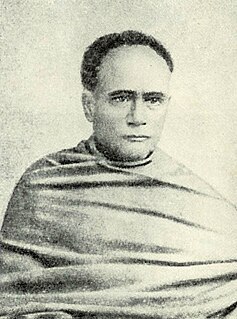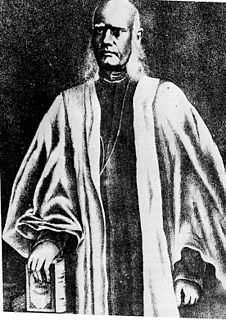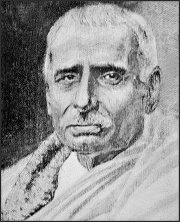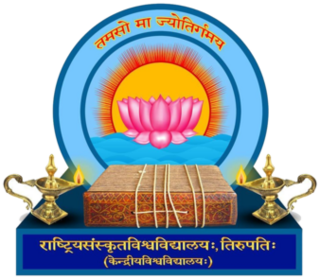
Sir Ashutosh Mukherjee was a prolific Bengali educator, jurist, barrister and mathematician. He was the first student to be awarded a dual degree from Calcutta University. Perhaps the most emphatic figure of Indian education, he was a man of great personality, high self-respect, courage and towering administrative ability. The second Indian Vice-Chancellor of the University of Calcutta for four consecutive two-year terms (1906–1914) and a fifth two-year term (1921–23), Mukherjee was responsible for the foundation of the Bengal Technical Institute in 1906, which was later known as Jadavpur University and the University College of Science of the Calcutta University in 1914.

Swami Bhuteshananda was born on 8 September 1901 at Somsar in Bengal Presidency. His premonastic name was Vijay Chandra. His father was Purna Chandra Roy and his mother Charubala Devi. In his student life, he met Jnan Maharaj. Under influence of his and some other spiritual young boys, he started to go to Belur Math frequently and he met many of the direct disciples of Sri Ramakrishna. He graduated from Government Sanskrit College where he mastered Bengali, English and Sanskrit. Due to his visits to the Math, one day he went to the Math to become Monk (Sannyasi), but as his studies was not completed, he was asked to come later. This made him leave his residence and he built a Shiva temple in Baghbazar (Calcutta) and lived there like a renunciate monk, practicing intense Tapasya. He was present during the funeral of Sri Sarada Devi, in December 1920.

Ishwar Chandra Vidyasagar CIE, born Ishwar Chandra Bandyopadhyay, was an Indian educator and social reformer of the nineteenth century. His efforts to simplify and modernise Bengali prose were significant. He also rationalised and simplified the Bengali alphabet and type, which had remained unchanged since Charles Wilkins and Panchanan Karmakar had cut the first (wooden) Bengali type in 1780. He is considered the "Father of Bengali prose".
Vidyasagar or Vidya Sagar may refer to:

Vidyasagar University was established by an Act of the West Bengal legislature which was notified in the Calcutta Gazette on 24 June 1981. It is an affiliating university in Paschim Medinipur district of southern West Bengal, India. It offers courses at the undergraduate and post-graduate levels.

Vidyasagar College is a state government-aided public college, affiliated to the University of Calcutta, located in North Kolkata, West Bengal, India. The college offers both post-graduate and under-graduate courses in a number of subjects of arts and science. Founded in 1872, it was the first private college in India which was purely run, maintained and financed by Indians. Formerly known as Metropolitan Institution, it was named after its founder Pandit Ishwar Chandra Vidyasagar in 1917.

Krishna Mohan Banerjee was a 19th-century Indian thinker who attempted to rethink Hindu philosophy, religion and ethics in response to the stimulus of Christian ideas. He himself became a Christian, and was the first president of the Bengal Christian Association, which was administered and financed by Indians. He was a prominent member of Henry Louis Vivian Derozio's (1808–1831) Young Bengal group, educationist, linguist and Christian missionary.

The University of Kalyani, established in 1960, is a Government of West Bengal administered, UGC affiliated, NAAC accredited, collegiate Public Research university in Kalyani, West Bengal, India. It offers courses at the Undergraduate, Postgraduate and Doctoral levels.
Rasikendra Nath Nandi a Vaishnav scholar, a social reformer and a zamindar was born in the village named Bhat-bera in district Pabna of undivided Bengal in 1882. As a serious scholar of Vaishnavism, he wrote several manuscripts explaining the Vaishnavism in simple Sanskrit. Apart from his scholarly activities, he established schools for spreading of modern education in Pabna and in Agarpara, where he died in 1962. Rasikendra Nath is one among those unsung stars of Bengal who was forgotten in the midst of political and economic turmoil of Bengal after Indian independence.

Sir Gooroodas Banerjee was a Bengali Indian judge of the Calcutta High Court. In 1890, he also became the first Indian Vice-Chancellor of University of Calcutta.

Hara Prasad Shastri, also known as Hara Prasad Bhattacharya, was an Indian academic, Sanskrit scholar, archivist and historian of Bengali literature. He is most known for discovering the Charyapada, the earliest known examples of Bengali literature.

Tibbetibaba also known as Mahasadhak Tibbetibaba or Paramhamsa Tibbetibaba, alternative spellings Tibbatibaba, Tibbati Baba, Tibbeti Baba, Tibbotibaba or Tibboti Baba born Nabin Chattopadhhyaya Bengali: নবীন চট্টোপাধ্যায়;Mahasamadhi or death – 19 November 1930) was a famous Bengali philosopher, saint and yogi. He was one of the few saints in India whose life was an amalgamation of the Advaita Vedanta doctrine of Hinduism and Mahayana Buddhist doctrine. Tibbetibaba was a master of all the eight siddhis and supposedly had remarkable healing powers. Even though he was master of all the siddhis, he was not personally interested in using them.
The Sanskrit Press and Depository was set up in 1807 by Baburam, who was a teacher at Hariram College, one of the primitive colleges in east Bengal. Later, Ishwar Chandra Vidyasagar and Madan Mohan Tarkalankar with a loan of 600 rupees updated it with better machinery and work-environment.

Serampore Union Institution is a Bengali medium boys' school in India, accredited as "A-Grade Excellent Educational Institution" by West Bengali Council of Higher Secondary Education for its brilliant and enviable academic performance. The school was inaugurated by Ishwar Chandra Vidyasagar. The school is affiliated to the West Bengal Board of Secondary Education and the West Bengal Council of Higher Secondary Education. It was established in 1884. In 2009, the school celebrated its 125th anniversary.

Sanskrit Collegiate School is one of the oldest schools in Kolkata, India, teaching grades from class 1 to 12 under the West Bengal Board of Secondary Education and the West Bengal Council of Higher Secondary Education. The boys-only school was established by the then Bengal intelligentsia along with Sanskrit College, Calcutta. The establishment date is 1 January 1824. It is situated opposite the Presidency University, Kolkata, College Square and Hindu School, Kolkata and next to the University of Calcutta and Hare School, Kolkata.

Nabadwip Vidyasagar College is a college affiliated to the University of Kalyani, situated in Nabadwip in Nadia, West Bengal, India. It was established in 1942 as a branch of Vidyasagar College, kolkata. It offers undergraduate courses in arts, commerce and sciences.

Anil Kumar Gain FRSS FCPS was an Indian mathematician and statistician best known for his works on the Pearson product-moment correlation coefficient in the field of applied statistics, with his colleague Ronald Fisher. He received his Ph.D. from the University of Cambridge under the supervision of Henry Ellis Daniels, who was the then President of the Royal Statistical Society. He was honoured as a Fellow of the Royal Statistical Society and the Cambridge Philosophical Society.

National Sanskrit University, earlier known as Rashtriya Sanskrit Vidyapeetha is a central university in Tirupati, Andhra Pradesh, India.

Satish Chandra Vidyabhusan was a Bengali scholar of Sanskrit and Pali Language and principal of Sanskrit College.

















